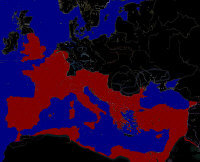A Brief History Lesson
Before we can understand how the legend of King Arthur developed, we first must understand a little about the world into which it was born. Historians still debate whether Arthur was a real person, and while there does seem to be some circumstantial evidence which indicates that he may have been based on a real historical figure, the fact remains that no one can say for certain that he was. Although most people today picture Arthur as having been an eleventh–century king, the earliest tales of Arthur actually place him as a warlord living in the late fifth or early sixth centuries. In order for us to understand how it is that the legends were born and what it was that caused them to become so popular and so widespread for centuries later, we need to understand a little bit about this world.
 Map of Europe in the 400s. The Roman Empire is colored in red.
Map of Europe in the 400s. The Roman Empire is colored in red.
During the fifth century, and for many centuries prior, Rome had been the most powerful military force in Europe. At its height, the Roman Empire controlled almost all of Western Europe, stretching as far south as northern Africa, as far East as Persia (present–day Iran), and as far north as the bottom portion of the British Isle.
The Romans were brutal tyrants, ruling each land they conquered with an iron fist, and crushing any enemy who dared step in their way. But they also provided peace and stability to the lands they conquered. They were experts at building roads to establish trade routes between their territories, large, powerful walls to defend their cities from invaders, and even aqueducts to provide water to territories that were isolated from any main water source. Some historians have even compared Roman–ruled Britain to the Old South in nineteenth–century America. To live in Rome was to live in the center of the civilized world.
In the late fifth century, the Roman Empire fell, and this was the beginning of the Medieval Ages. In reality, Rome did not fall all at once, but rather, gradually declined, as citizens lost faith in the government and its military could no longer afford to defend its territories, gradually abandoning more and more of them to invaders. The causes of Rome's fall are many, and are the subject of much discussion among scholars, and many thick books. As such, they are beyond the scope of this article.
But for whatever reason, Rome did fall, and as it abandoned more and more of its territories or lost them to invaders, the people who had spent their entire lives in relative peace and civility under the protection of the Roman Empire suddenly found themselves in a world for which they were vastly unprepared: being left to defend themselves against invaders who pillaged their land and raped their wives, being unable to provide basic food for their families and loved ones, and living every day in perpetual fear of annihilation. They couldn't even fix the older Roman machinery on which they'd become dependent for daily living, or repair the city walls which had protected them from invaders in the past, because no one knew how to fix these things once the Empire withdrew, leaving the common people behind.
One can imagine the sense of hopelessness that would be felt by a typical lay person of today if his government and society were to collapse, and his home were to be overrun by invaders. This is the world which gave birth to the legends of King Arthur.

